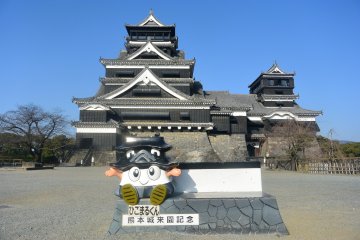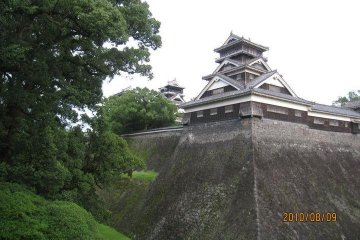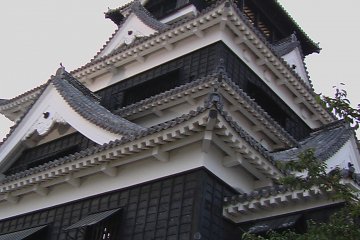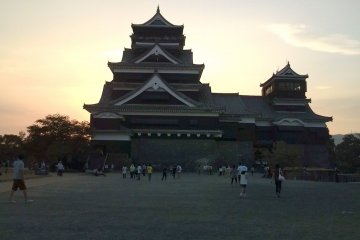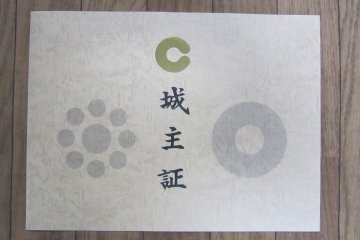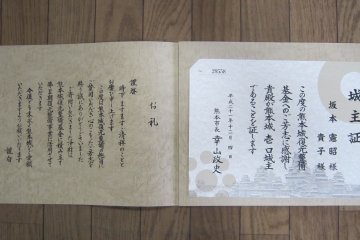There are many old castles in Japan, but I love Kumamoto Castle the most, because compared to other castles, it looks so formidable and masculine.
There is an certain reason why this castle looks so masculine. After some bumps and detours, Tokugawa Ieyasu finally realized his life-long dream and founded the Tokugawa Shogunate in 1603. Since its foundation, the Tokugawa government didn't give Daimyos (lords) of regional domains permission to reinforce or rebuild their castles easily. The Tokugawa clan just happened to be the strongest Daimyo of all Daimyos in Japan at the time, and seized the opportunity to found the Tokugawa Shogunate. Thereafter, each Daimyo had to obey Tokugawa and become its subordinates or else be terminated. However, they were originally enemies, so Tokugawa government was always careful, watching over every move of their subordinate Daimyos.
However, Kumamoto Castle was an exception. For 265 long years, from the beginning of the Tokugawa (Edo) Era till the end, what the Tokugawa Shogunate feared most was the Shimazu clan in Satsuma (present day Kagoshima), which had been the prestigious leaders of Kyushu for a long time. Thus they had a lot of loyal subordinates who were well-known for their military strength. Although the Shimazu clan obeyed the dictates of the Tokugawa clan after the Battle of Sekigahara, Tokugawa continued to fear them for their formidable strength. Therefore, after the Battle of Sekigahara Tokugawa Ieyasu ordered Kato Kiyomasa, who had been granted the fiefdom of Kumamoto, to build the castle strong enough to hold out against Shimazu's powerful army. Kumamoto is the first place Shimazu would invade if they tried to overturn the Tokugawa Shogunate, so stopping Shimazu in Kumamoto was of great importance.
Thus ordered, Kato Kiyomasa, well-known man of valor and military prowess, built Kumamoto Castle with his utmost wisdom and care so as to be capable of defeating Shimazu, the strongest enemy of Tokunaga clan. That's why Kumamoto Castle IS formidable and masculine. Fortunately, Kumamoto Castle didn't see any battles during the Tokugawa Era, but in 1877, nine years after the Tokugawa Shogunate was overturned, 14,000 Satsuma rebels (ex Shimazu troops) led by Saigo Takamori attacked Kumamoto Castle. Their enemy was not the Tokugawa clan any more, but the new Meiji government. Although they attacked the castle for three days, 4,000 goverment troops which defended the castle from inside warded off 14,000 Satsuma rebels, which in the end had to retreat from the impenetrable Kumamoto Castle. It is surprising that the castle that was built to oppose the Shimazu (Satsuma) clan in 1606 would actually defeat Shimazu troops later in 1877, 271 years after it was built, and could still ward them off even though opponents were armed with modern artillery! Kato Kiyomasa did a great job!
By the way, IF you were given the opportunity to become the Lord of this 'Cool' Kumamoto Castle, would you take it? Me? Of course I would jump at a chance! And so I DID jump at a chance.
Kumamoto Castle has introduced a new fund raising system called "Micro Lordship System". They have been using it to raise donations from all over the world for the restoration/maintenance of the castle. Anybody can contribute, and the minimum donation is 10,000 yen. If you donate 10,000 yen to Kumamoto Castle, you'll receive a 'Certificate of Micro-Lordship', and 'The Micro Lord's Free Pass'. Also, your name will be written on a wooden nameplate which will be displayed inside the main tower of Kumamoto Castle. By showing the Free Pass you can enter 16 facilities that are run by Kumamoto City (including Kumamoto Castle) for free. The Free Pass expires depending on how much you contribute; for 10,000 yen, the free period will be for a year, for 100,000 yen, for 10 years.
However, I didn't donate just because I wanted to have the Free Pass, which wouldn't be useful unless I lived in Kumamoto, and I don't. What attracted me most in this system was their promise to the contributors, "Your name will be recorded in their book of 'Eternal Record', which will be preserved inside the castle tower of Kumamoto Castle FOREVER". I don't know how long 'FOREVER' is, but at least my name will stay alive with the castle sometime after I die. Living forever with the castle...I love how that sounds! Of course I couldn't resist it, could I?! For your information, there are computers set up in the basement floor and on the 1st floor by which you can search out your name and find out where your nameplate is displayed inside the castle. If your nameplate is displayed in the castle, you'd want to visit and see it for yourself, wouldn't you? So this donation system not only attracts donors but also acquires repeater visitors to the castle. Within four years (2009-2013) it's collected 543,000,000 yen from 44,309 contributors.
Since I was curious how foreign names would be written on the nameplates, and because one of my American friends was a big fan of Japanese castles, I made a donation on behalf of him along with my own donation. His name was written in English 'vertically', and his nationality was also mentioned in Japanese as 'The United States of America' (see photo). When I sent the documents (certificates, etc.) which prove his 'Lordship', he jumped up and down and said, "I WILL DEFINITELY visit Kumamoto Castle when I come to Japan next time!" It looks like Kumamoto Castle has acquired one more fan from beyond the sea due to this ingenious"Micro Lordship System".
So, why don't you have a try? If you do, you can live within the masculine and cool Kumamoto Castle forever! As the castle is one of the important cultural properties of Japan, even if you die, it will survive with your name!




